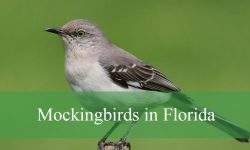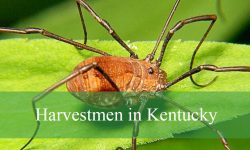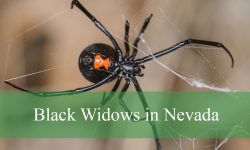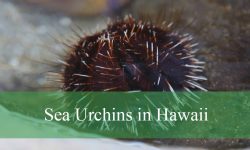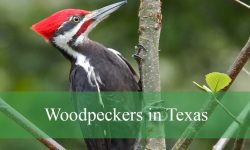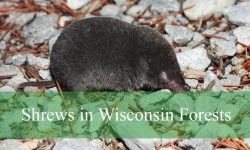Florida’s vibrant landscapes host an impressive variety of green birds that catch the eye with their brilliant colors and unique behaviors. From native herons to exotic parrots, these birds enrich wetlands, forests, and city parks alike.
Bird lovers and nature enthusiasts will find joy in spotting these vivid green species, each playing an important role in Florida’s diverse ecosystems. Their striking plumage and fascinating habits make them unforgettable sights for observers.
This guide introduces 20 stunning green birds found throughout Florida, featuring helpful identification tips and beautiful pictures. Explore the colorful world of these avian residents and learn where to find them in the wild.
Common Green Birds Found in Florida
Green Parakeet (Psittacara holochlorus)
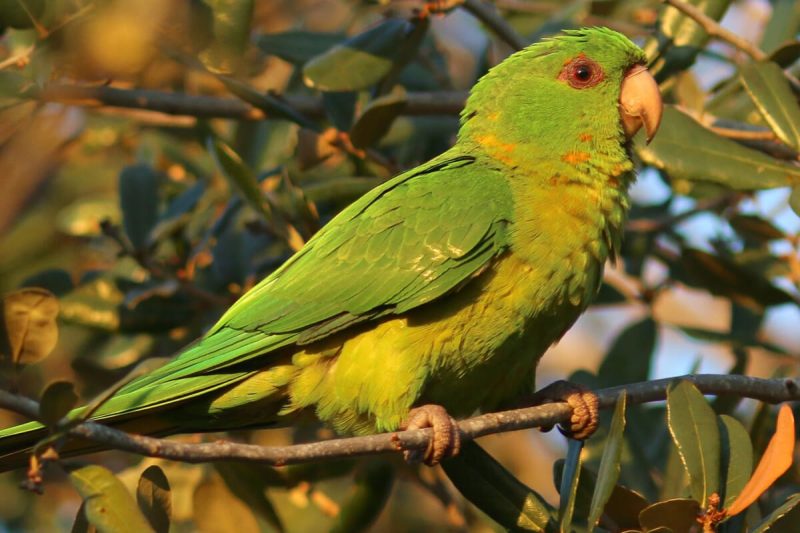
The Green Parakeet is a medium-sized parrot about 12 to 14 inches long, displaying bright green feathers with subtle yellowish highlights on the wings and tail. Its strong, curved beak is perfect for cracking seeds and fruits, which make up the bulk of its diet. While native to Central America, small feral populations have been spotted in southern Florida, mostly in urban parks and wooded areas. These birds are highly social and often gather in noisy flocks communicating through a variety of sharp, chattering calls.
Green Parakeets inhabit places with abundant food and suitable nesting sites such as tree cavities or abandoned woodpecker holes. During breeding, females typically lay three to five eggs, which are incubated for about 24 days by both parents. Once hatched, the chicks are fed and protected cooperatively until fledging. These birds remain active throughout the day and are frequently observed flying in groups and foraging together.
The adaptability of Green Parakeets to urbanized environments has enabled their persistence outside their native range, although their numbers in Florida remain limited and localized. Their vibrant coloration and loud vocalizations make them an easily recognizable addition to the state’s exotic bird community. Availability of nesting sites plays a crucial role in their breeding success.
An interesting fact about Green Parakeets is their ability to mimic human speech and other sounds in captivity, showcasing their intelligence. In the wild, their vocalizations serve vital functions in maintaining flock cohesion and defending territories.
Monk Parakeet (Myiopsitta monachus)
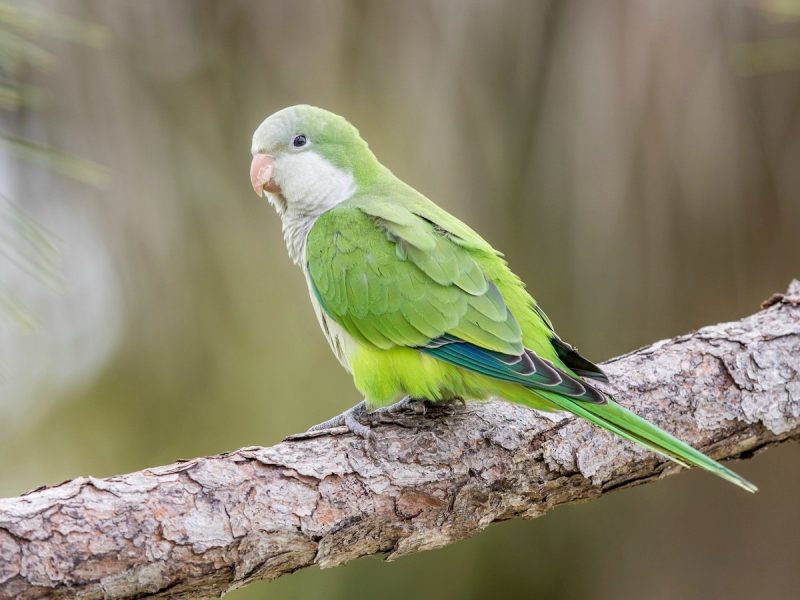
Monk Parakeets, also called Quaker Parrots, measure approximately 11 to 12 inches in length and have bright green plumage complemented by a grayish face and chest. This distinct coloration helps distinguish them from other green parrots. Native to South America, these birds have established feral populations in Florida, particularly in urban and suburban areas. Their strong hooked beaks enable them to feed on a variety of seeds and nuts.
Unlike most parrots that nest in tree cavities, Monk Parakeets build large communal nests made of sticks, which may contain multiple chambers housing many breeding pairs. These nests can weigh over 100 pounds and are commonly found on trees, utility poles, or human structures. Their social behavior and noisy calls make them conspicuous residents of their chosen habitats.
Monk Parakeet pairs share incubation and chick-rearing duties, typically laying four to eight eggs per clutch with an incubation period of about 23 to 24 days. The communal nest provides protection from predators and environmental challenges, contributing to the species’ success in new environments. Outside the breeding season, they continue to roost communally.
A fun fact about Monk Parakeets is their unique nest-building habits, which resemble those of some mammals or birds of prey rather than typical parrots. Their adaptability to urban life has allowed them to thrive far from their native range.
Nanday Parakeet (Aratinga nenday)
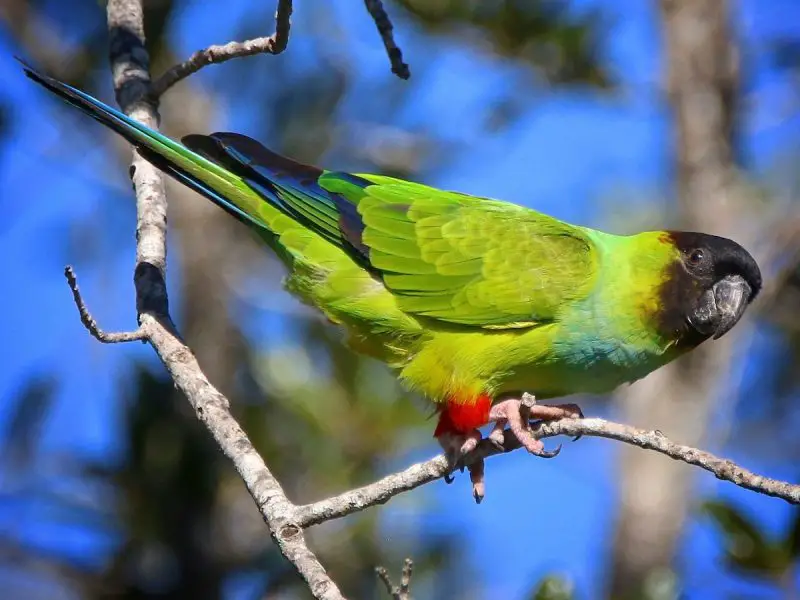
The Nanday Parakeet, or Black-hooded Parakeet, is a striking bird about 13 to 15 inches long. It sports a bright green body contrasted sharply by a black facial mask, with blue and turquoise wing patches and a long blue-green tipped tail. Native to South America, this species has become established in Florida following escapes or releases. They are gregarious and often form noisy flocks that forage in parks, wooded areas, and suburban neighborhoods.
Their diet mainly consists of seeds, fruits, and berries. These adaptable birds thrive in urban environments and are easily recognizable by their loud calls. For nesting, they use tree cavities or abandoned nests of other birds. Females lay between three and six eggs and incubate them for about 23 days, while both parents care for the chicks until fledging.
Nanday Parakeets display aggressive territorial behavior that can lead to competition with native species. Nonetheless, their resilience and social nature have enabled them to maintain stable populations in Florida’s altered landscapes. Their success demonstrates a high degree of ecological flexibility.
An interesting fact about the Nanday Parakeet is its aggressive defense of territory and adaptability to urban environments, making it a notable example of an invasive species thriving outside its native range.
Red-masked Parakeet (Psittacara erythrogenys)
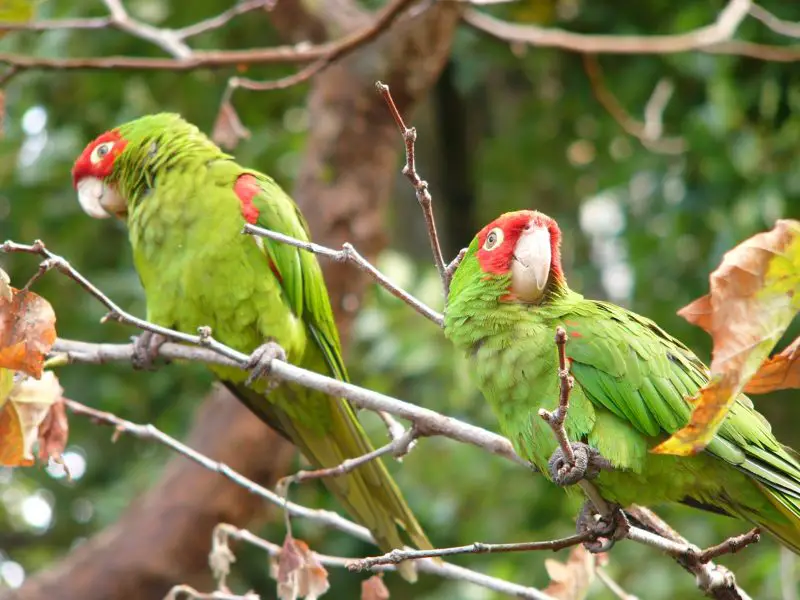
The Red-masked Parakeet is a medium-sized parrot measuring about 12 to 14 inches in length. It has bright green plumage with a vivid red patch on its forehead and face, setting it apart from many other green parrots. Its wings have subtle blue-green feathers, and the tail displays a mix of red and green. Native to western Ecuador and Peru, this species has established feral populations in Florida’s urban and suburban areas.
These birds are highly social and often form noisy, energetic flocks. They forage mainly on fruits, seeds, and nuts found in trees and shrubs. Their loud calls and agile flight make them popular among birdwatchers spotting exotic species in Florida. They adapt well to human-altered habitats where food and nesting sites are abundant.
Red-masked Parakeets nest in tree cavities, abandoned woodpecker holes, or sometimes in man-made structures. Females lay three to six eggs per clutch, and both parents share incubation and feeding duties. Nesting typically occurs during warmer months when resources are plentiful.
A fun fact about Red-masked Parakeets is their combination of striking appearance and boisterous behavior, which makes them favorites among enthusiasts observing Florida’s feral parrots. Their establishment also provides valuable insights into invasive species dynamics.
White-winged Parakeet (Brotogeris versicolurus)

The White-winged Parakeet is a small, vibrant green parrot measuring about 11 inches long. Its most distinctive feature is the prominent white patches on its wings, which become very visible during flight. The bird’s face is green with a slightly lighter throat and belly, and its tail feathers are long and tapered. Native to South America, this species has established feral populations in Florida, especially around urban areas where it often inhabits parks and gardens.
These parakeets are highly social and form noisy flocks that forage together. Their diet consists mainly of fruits, seeds, flowers, and occasionally insects. White-winged Parakeets prefer nesting in tree cavities but will also use artificial structures if natural sites are scarce. Their adaptability to different habitats, including suburban settings, has contributed to their successful establishment outside their native range.
Breeding pairs share incubation duties, with females laying between three and six eggs. Incubation typically lasts around 23 days, and both parents feed and care for the chicks until they fledge several weeks later. The communal nature of these birds extends beyond breeding, as flocks roost and travel together daily.
A fascinating fact about White-winged Parakeets is their ability to thrive in urban environments by exploiting a wide variety of food sources and nesting sites. Their distinctive white wing patches make them a favorite among birdwatchers looking for exotic species in Florida.
Painted Bunting (Passerina ciris)

The Painted Bunting is a small songbird celebrated for its vivid and colorful plumage. Males display a spectacular mix of blue heads, green backs, and red underparts, while females are a more subdued greenish-yellow, which helps them stay camouflaged. Measuring about 5 inches in length, this bird inhabits Florida primarily during the breeding season and prefers dense shrubbery, woodland edges, and thickets.
Painted Buntings are known for their shy and secretive behavior, often remaining hidden in thick vegetation. They feed mainly on seeds, berries, and insects, using their strong conical bills to crack seeds efficiently. These birds are territorial during breeding, with males singing bright, melodic songs to defend their territory and attract mates.
During nesting, females build cup-shaped nests low in bushes or trees, laying three to four eggs per clutch. The incubation period lasts approximately 12 to 14 days. After hatching, the chicks are cared for by both parents until they fledge within two weeks. Painted Buntings migrate seasonally, with northern populations moving south during colder months.
A fun fact about Painted Buntings is that despite their dazzling colors, they are quite elusive and difficult to spot, making sightings a special treat for birdwatchers in Florida and beyond.
Rose-ringed Parakeet (Psittacula krameri)
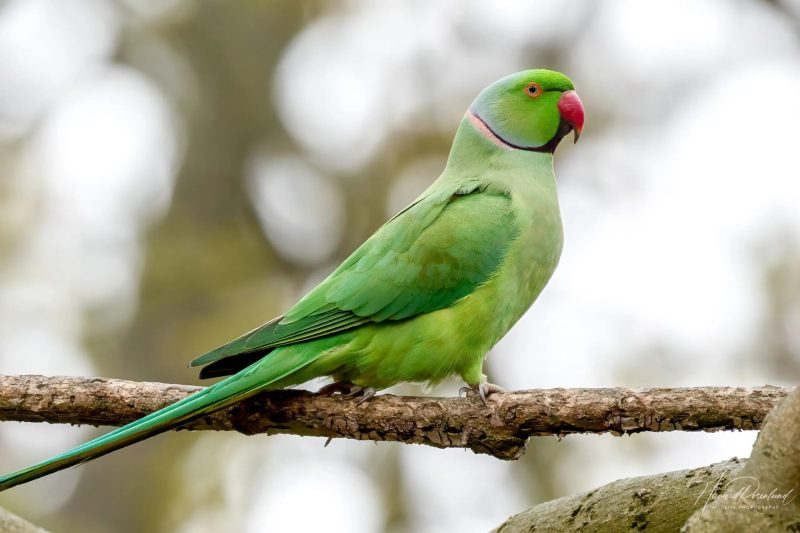
The Rose-ringed Parakeet, also known as the Ring-necked Parakeet, is a striking medium-sized parrot approximately 16 inches long. It exhibits bright green plumage with a distinctive red beak and a black and rose-colored ring around the neck in males. Native to parts of Africa and South Asia, this species has established feral populations in several parts of the world, including Florida’s urban areas.
Rose-ringed Parakeets are highly adaptable and social birds, often found in flocks that forage in parks, gardens, and wooded areas. Their diet mainly consists of fruits, seeds, nuts, and blossoms. These parakeets nest in tree cavities, and during breeding season, females lay three to four eggs which hatch after about 23 days. Both parents share incubation and feeding responsibilities.
This species is known for its loud, harsh calls and its ability to thrive in human-dominated environments. Their bright coloration and vocal nature make them easily noticeable and popular among bird enthusiasts. Rose-ringed Parakeets can sometimes compete with native birds for food and nesting sites.
A fun fact about the Rose-ringed Parakeet is their remarkable adaptability, having successfully colonized urban areas far from their native ranges, demonstrating impressive ecological flexibility.
Cuban Parrot (Amazona leucocephala)
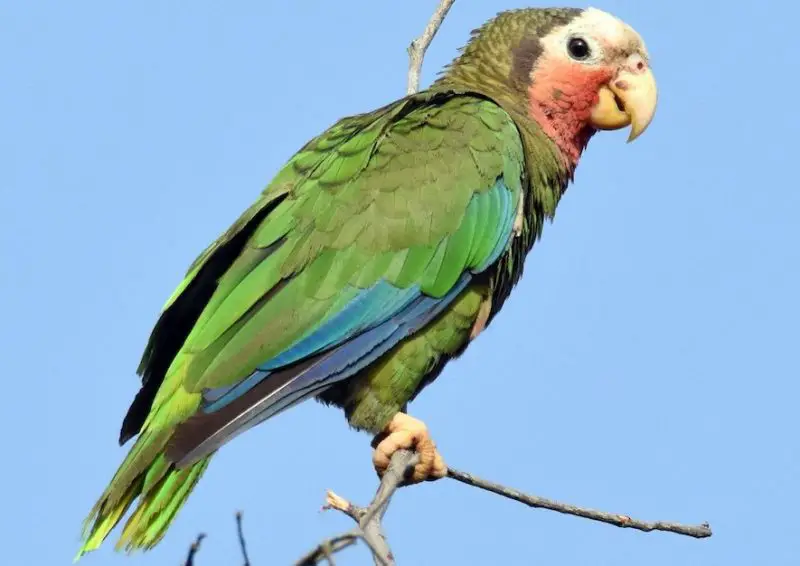
The Cuban Parrot is a medium-sized parrot about 12 to 14 inches in length, primarily bright green with blue and turquoise highlights on its wings. It has a pale forehead and a strong curved beak suited for cracking nuts and seeds. Although native to Cuba and the Bahamas, small populations have been reported in Florida, often due to escapees or released pets.
Cuban Parrots are social and vocal birds that forage in flocks, feeding on fruits, seeds, nuts, and flowers. They typically nest in tree cavities and sometimes in limestone cliffs in their native habitat, laying 2 to 4 eggs per clutch. Incubation lasts around 28 days, with both parents participating in feeding and care of the young.
In Florida, these parrots tend to inhabit wooded parks and suburban areas where food is plentiful. They are shy compared to some other feral parrot species but can be heard making a variety of calls. Their conservation status is of concern in native ranges due to habitat loss.
A notable fact about the Cuban Parrot is its strong site fidelity during breeding and its ability to thrive in mixed-species flocks, which enhances their survival and foraging success.
Red-crowned Parrot (Amazona viridigenalis)
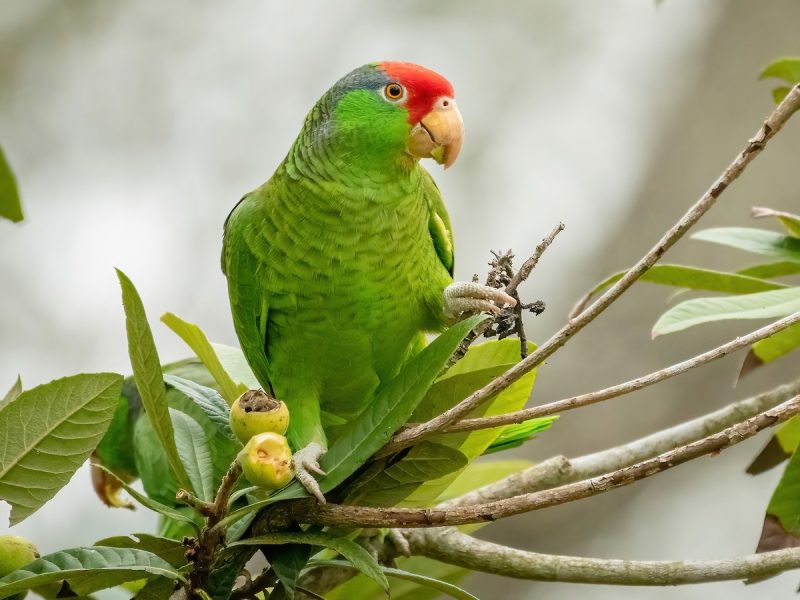
The Red-crowned Parrot is a medium-sized parrot approximately 14 inches long with predominantly green plumage and a distinctive bright red patch covering its forehead and crown. The rest of its body is mostly bright green with some blue on the wings and tail feathers. Native to northeastern Mexico, this species has established a stable feral population in Florida, especially around urban and suburban parks and gardens. Their strong curved beak helps them feed on fruits, nuts, seeds, and berries, allowing them to thrive in diverse habitats.
These parrots are highly social and often found in noisy flocks that forage and roost together. They prefer nesting in tree cavities or abandoned woodpecker holes and sometimes utilize man-made structures for nesting sites. During breeding, females typically lay three to four eggs, which both parents incubate for about 26 days. After hatching, both parents actively feed and care for the chicks until they fledge several weeks later.
Red-crowned Parrots have adapted well to Florida’s urban environments, showing remarkable flexibility in diet and nesting habits. Their loud calls and vibrant colors make them noticeable and popular among birdwatchers, although their presence sometimes causes conflicts with native bird species due to competition for resources. Despite this, they play an important ecological role by dispersing seeds and contributing to the urban ecosystem.
An interesting fact about Red-crowned Parrots is their intelligence and ability to mimic sounds and human speech, traits common among parrots. Their successful adaptation outside their native range highlights the species’ resilience and adaptability.
Yellow-chevroned Parakeet (Brotogeris chiriri)
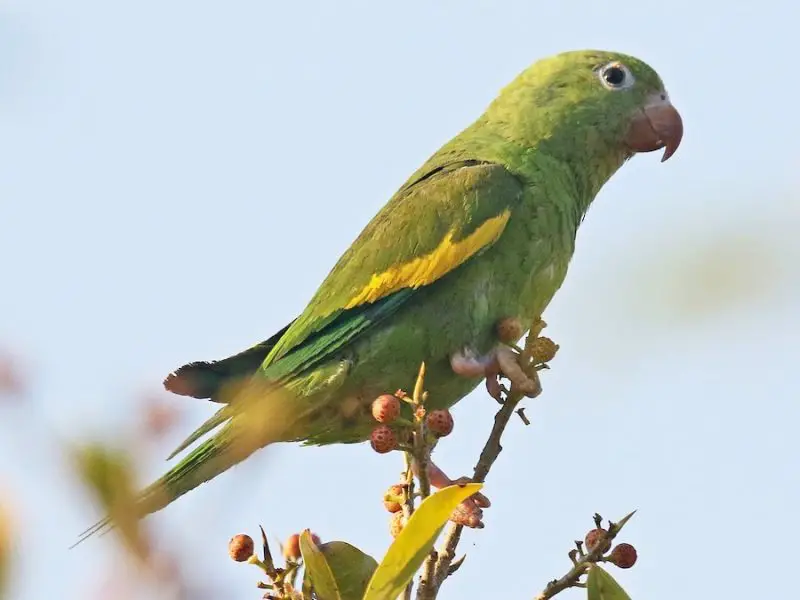
The Yellow-chevroned Parakeet is a small parrot about 10 inches long, easily recognizable by the bright yellow patches on the edges of its wings, which resemble chevrons. The rest of its plumage is vibrant green with a pale bill and grayish legs. Originally native to South America, this species has established feral populations in Florida, particularly in suburban areas and parks. These birds are active, social, and often form large flocks, creating a lively presence wherever they inhabit.
Their diet consists primarily of seeds, fruits, flowers, and buds, which they forage for in trees and shrubs. Yellow-chevroned Parakeets nest in tree cavities but are also known to use man-made structures, making them adaptable to urban environments. Females lay between three and six eggs per clutch, and both parents share incubation and feeding duties, with incubation lasting around 23 days.
These parakeets are highly vocal, producing a variety of chattering calls that help maintain flock cohesion. Their gregarious nature and adaptability have contributed to their successful establishment outside their native range. While generally not considered a threat to native species, their expanding populations require monitoring to understand their ecological impact.
A fun fact about Yellow-chevroned Parakeets is their strong flocking behavior, which helps them avoid predators and find food efficiently. Their bright yellow wing markings also make them easily distinguishable from other green parakeets in Florida.
White-crowned Parrot (Pionus senilis)
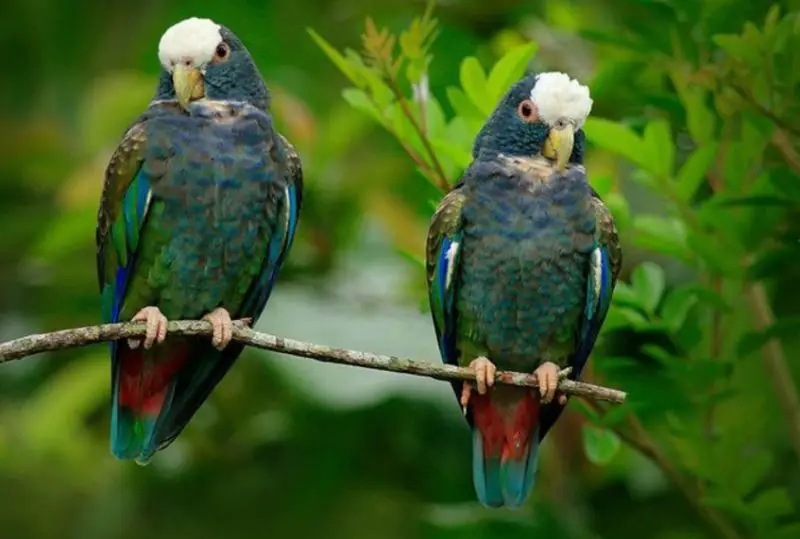
The White-crowned Parrot is a medium-sized parrot about 12 inches long, predominantly green with a striking white patch on the crown of its head. It also has subtle blue and red markings on the wings and tail, adding to its distinctive appearance. Native to Central America, feral populations have been reported in Florida, particularly in urban and suburban areas. These parrots are known for their quiet and less conspicuous behavior compared to other parrot species.
White-crowned Parrots feed primarily on fruits, nuts, seeds, and berries, foraging in trees and shrubs. They nest in tree cavities and often prefer natural holes, though they may use artificial nesting sites when available. The female lays three to five eggs, and incubation lasts about 25 days, with both parents sharing the responsibility of feeding the young until fledging.
Their shy nature and relatively low vocalization volume make them less noticeable in the wild, though they are highly social within their flocks. Their ability to adapt to human-altered landscapes has allowed them to survive and reproduce in Florida’s urban environments. Their diet flexibility and nesting habits contribute to their persistence outside their native range.
An interesting fact about White-crowned Parrots is that they are among the quieter parrot species, often communicating through soft whistles and chattering, which contrasts with the loud calls typical of many other parrots.
Yellow-headed Parrot (Amazona oratrix)

The Yellow-headed Parrot is a striking bird about 15 inches long, mostly green with a bright yellow head and neck. The plumage also features some blue and red accents on the wings and tail feathers. Native to Central America, this species is considered endangered in its native range but has established small feral populations in Florida. Their powerful beaks enable them to crack hard nuts and seeds, which are important food sources in their diet.
Yellow-headed Parrots are social birds, typically forming flocks that forage together in forests, woodlands, and urban green spaces. They nest in tree cavities and sometimes use abandoned nests of other species. Females usually lay three to four eggs per clutch, with incubation lasting about 26 days. Both parents care for the chicks and remain protective of their nesting territories.
Despite their endangered status in native habitats due to deforestation and capture for the pet trade, their adaptability has helped them persist in introduced areas like Florida. Their striking yellow heads make them easily identifiable, and they contribute to seed dispersal in their ecosystems.
A notable fact about the Yellow-headed Parrot is its endangered conservation status, which contrasts with its relatively stable introduced populations in Florida. This highlights the complexity of species conservation and the effects of invasive populations.
Lilac-crowned Parrot (Amazona finschi)

The Lilac-crowned Parrot is a medium-sized parrot approximately 14 inches long, characterized by its bright green body and distinctive lilac-colored crown. Its wings and tail feathers include blue and red highlights, adding to its colorful appearance. Native to Mexico, this species has established small feral populations in Florida, mainly around urban areas with abundant trees.
These parrots feed on fruits, seeds, nuts, and flowers, often foraging in groups. They nest in tree cavities and occasionally in urban structures, with females laying three to five eggs per clutch. The incubation period lasts about 25 days, and both parents participate in feeding and protecting the young until fledging.
Lilac-crowned Parrots are social and vocal birds, producing a variety of loud calls that help maintain group cohesion. Their adaptability to different habitats, including suburban environments, has facilitated their success outside their native range. Their bright lilac crown makes them one of the more easily recognizable parrots among Florida’s feral populations.
A fun fact about the Lilac-crowned Parrot is its distinctive crown color, which is unique among Amazona parrots in Florida, making it a favorite species for birdwatchers and parrot enthusiasts.
Mitred Parakeet (Psittacara mitratus)
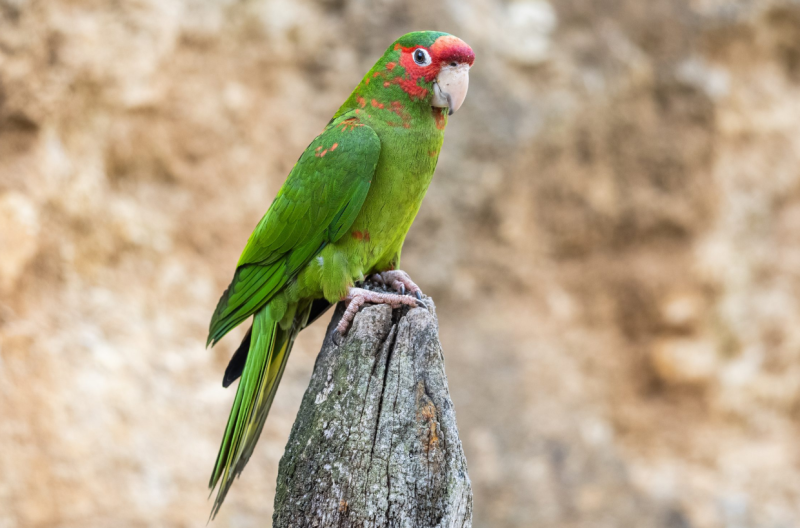
The Mitred Parakeet is a medium-sized parrot about 14 inches long, featuring predominantly bright green plumage with distinctive red markings on the forehead and around the eyes, giving it a “mitred” appearance reminiscent of a bishop’s hat. Native to the Andean regions of South America, feral populations have been established in Florida, particularly in urban parks and residential neighborhoods. Their strong, curved beaks are adapted for cracking a variety of seeds, fruits, and nuts, which constitute the bulk of their diet.
These birds are highly social and tend to form noisy flocks that forage and roost together. Mitred Parakeets nest in tree cavities or abandoned nests of other birds, and sometimes they adapt to artificial nesting sites in urban environments. During the breeding season, females lay three to five eggs, which both parents incubate for around 23 to 26 days. After hatching, the parents diligently feed and protect their young until they fledge several weeks later.
Mitred Parakeets have demonstrated a remarkable ability to adapt to Florida’s urban landscapes, thriving in areas with ample food and nesting opportunities. Their loud, harsh calls make them easily noticeable, and they have become a familiar sight to local birdwatchers. Their social behavior and vocalizations help maintain flock cohesion and territory defense.
An interesting fact about Mitred Parakeets is their vocal mimicry abilities, which allow them to imitate sounds from their environment, including human speech, making them popular in captivity and fascinating in the wild.
Blue-crowned Parakeet (Thectocercus acuticaudatus)
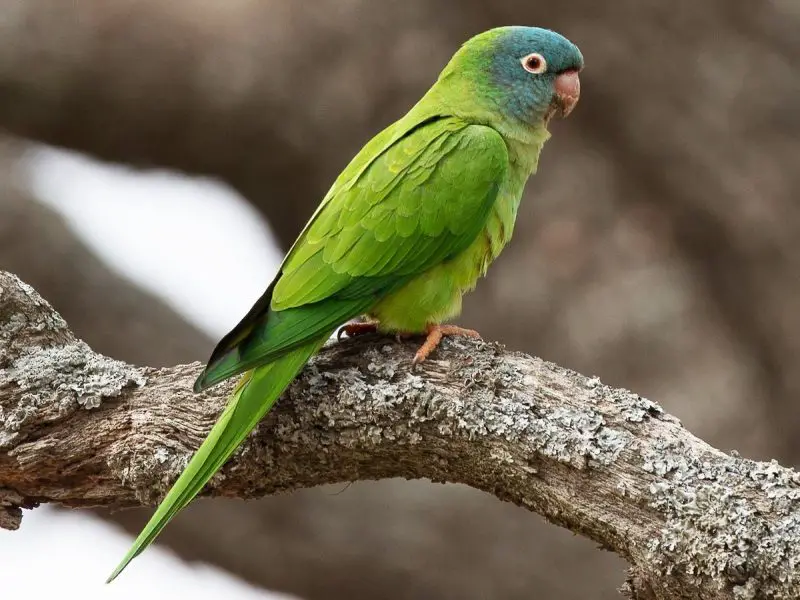
The Blue-crowned Parakeet is a medium-sized parrot measuring about 13 inches in length. It is mainly green with a bright blue crown on its head, distinguishing it from other green parakeets. Native to South America, especially regions of Brazil and Argentina, this species has small feral populations in Florida. Its curved beak is well-suited for eating seeds, fruits, and nuts found in various habitats.
Blue-crowned Parakeets are social birds that form flocks and are often seen flying and foraging together. They nest in tree cavities, preferring natural holes but also using man-made structures when available. Females lay three to five eggs, with an incubation period of approximately 23 days. Both parents share incubation and feeding duties, ensuring the chicks are well cared for until fledging.
These parakeets are known for their noisy and lively behavior, often vocalizing loudly to communicate within the flock. Their adaptability to different environments, including urban settings, has helped them survive and reproduce outside their native range. Their blue crown makes them easily identifiable and a favorite for bird enthusiasts.
A fun fact about Blue-crowned Parakeets is their ability to live in a variety of habitats, from forests to city parks, showcasing their ecological versatility and resilience.
Peach-fronted Parakeet (Eupsittula aurea)
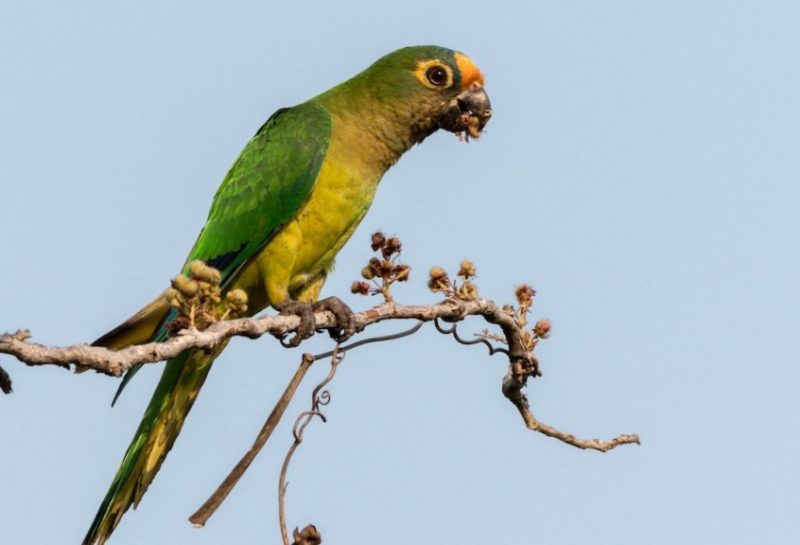
The Peach-fronted Parakeet is a small to medium-sized parrot approximately 11 to 13 inches long, mainly green with a distinctive peach or orange-colored patch on its forehead, bordered by a yellow line. Native to central South America, including Brazil and Bolivia, small feral populations have been recorded in Florida. Its diet mainly consists of seeds, fruits, and flowers.
These parakeets are highly social and often seen in large flocks feeding on seeds in open woodlands, savannas, and urban parks. They nest in natural cavities, termite mounds, or even in holes in banks and cliffs. Females typically lay four to six eggs, with an incubation period lasting about 23 days. Both parents participate in raising the young.
Peach-fronted Parakeets are known for their lively behavior and loud calls, often heard in flight or while feeding. Their bright peach forehead adds a splash of color that distinguishes them from other green parrots in the region. Their success in Florida highlights their adaptability to new environments.
An interesting fact about Peach-fronted Parakeets is their unique nesting habit of sometimes using termite mounds for breeding, a rare behavior among parrots that provides additional protection for their eggs and chicks.
Orange-chinned Parakeet (Brotogeris jugularis)
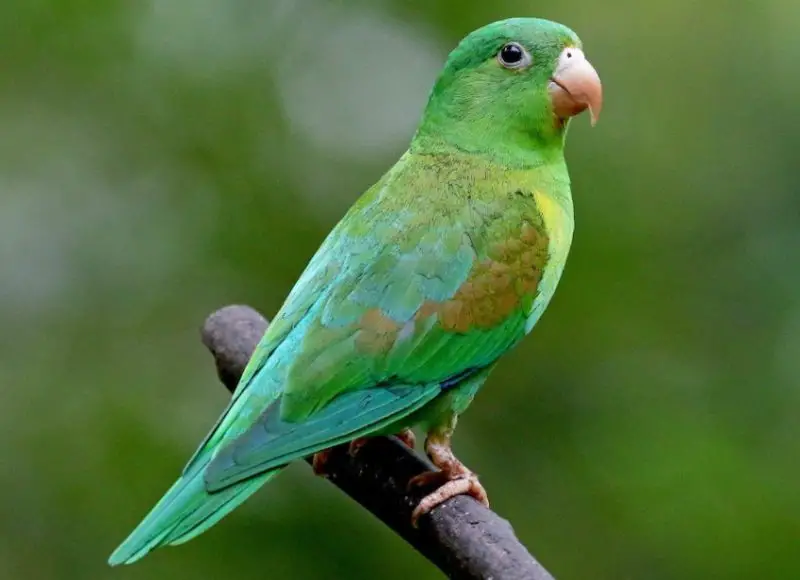
The Orange-chinned Parakeet is a small, slender parrot about 9 to 10 inches long, predominantly green with a subtle orange patch on the chin, which gives the species its name. Native to Central and northern South America, small feral groups have been observed in Florida. These birds are agile fliers and prefer forest edges, gardens, and urban parks.
Their diet is primarily composed of seeds, fruits, and nectar. Orange-chinned Parakeets nest in tree cavities or termite nests, where females lay between three and five eggs. Incubation takes about 23 days, and both parents are involved in caring for the chicks until they fledge. These birds are highly social and often forage in small flocks.
The species is known for its soft, high-pitched calls that differ from the louder, harsher calls of other parakeets. Their discreet behavior and smaller size make them less conspicuous, though their bright green feathers and orange chin are distinctive upon closer observation.
A fun fact about Orange-chinned Parakeets is their preference for nesting in termite mounds, providing natural insulation and protection, which is an unusual strategy among parrots.
White-fronted Amazon (Amazona albifrons)
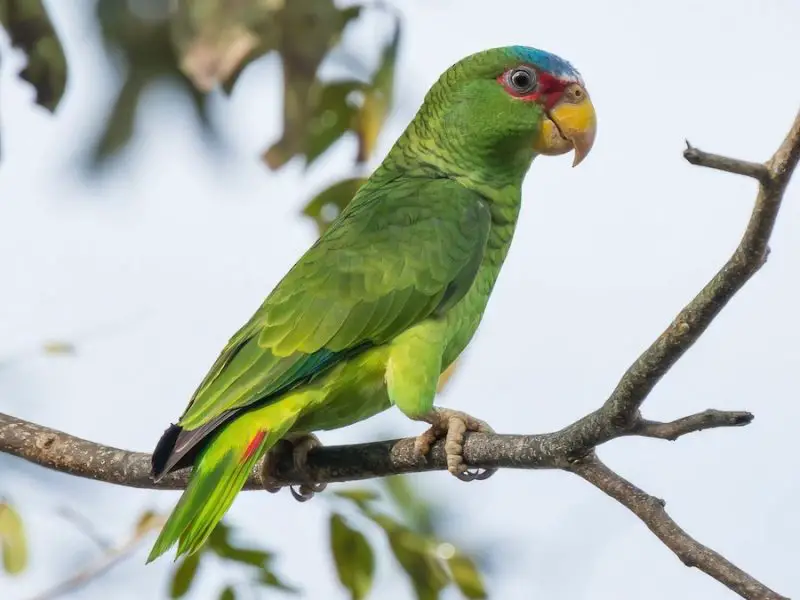
The White-fronted Amazon is a medium-sized parrot about 12 inches long, mostly green with a prominent white patch on the forehead just above the beak. It also has red markings on the wings and blue highlights on the head and tail. Native to Central America, small feral populations have been reported in Florida. These birds feed on a variety of fruits, seeds, nuts, and flowers.
White-fronted Amazons are social birds, often forming flocks that forage together in woodlands, parks, and suburban areas. They nest in tree cavities, where females lay three to five eggs, incubating them for approximately 26 days. Both parents share the duties of incubation and feeding the chicks until they are ready to fledge.
These parrots are known for their loud, raucous calls that can carry long distances, useful for maintaining contact within flocks. Their adaptability to human-altered landscapes has allowed them to survive in introduced areas, though they remain less common than some other feral parrot species in Florida.
An interesting fact about White-fronted Amazons is their ability to mimic human speech and other environmental sounds, which makes them popular pets and fascinating subjects in the wild.
Green Heron (Butorides virescens)
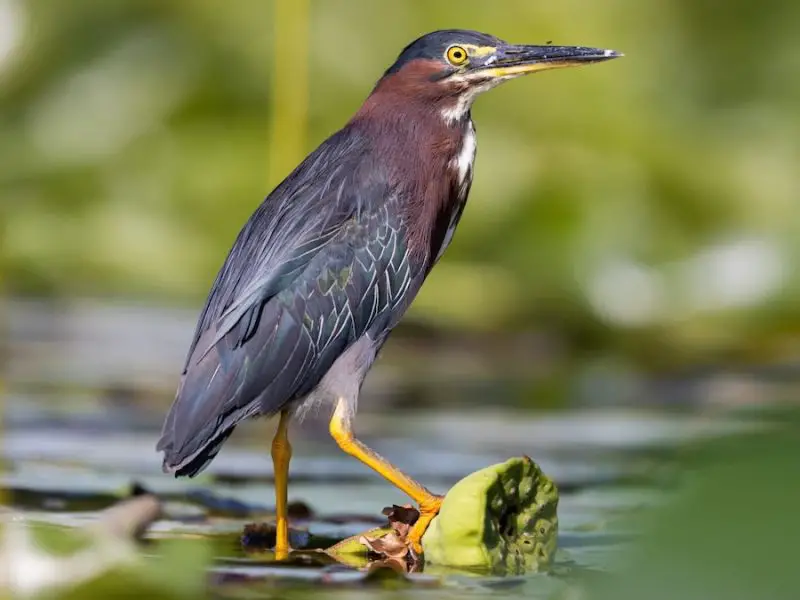
The Green Heron is a small, stocky bird measuring around 16 to 18 inches in length with a wingspan close to 25 inches. It displays a distinctive dark greenish-black cap and back, while its chest and neck exhibit a warm chestnut color. The wings are a glossy greenish-blue, giving it a shimmering appearance in sunlight. Its legs are relatively short and yellow-orange, and the bill is sharp and dagger-like, perfectly adapted for catching prey.
This bird is often found near freshwater wetlands such as marshes, ponds, swamps, and slow-moving streams throughout Florida. It prefers dense vegetation near the water’s edge where it can stay hidden while hunting. The Green Heron hunts primarily by standing motionless or stalking slowly, using its keen eyesight to catch small fish, frogs, crustaceans, and insects. Remarkably, it sometimes uses bait — dropping insects or feathers on the water to lure fish closer.
Breeding occurs from spring to summer when the Green Heron builds a loose platform nest of sticks in trees or shrubs, typically over water. The female lays three to five pale blue eggs, which both parents incubate for about 20 days. After hatching, the chicks are fed by both parents until they fledge in approximately three weeks.
A fun fact about the Green Heron is its tool-use behavior, which is quite rare among birds. Using bait to attract prey demonstrates notable intelligence and adaptability, making this species a fascinating subject for bird enthusiasts.
FAQs about Green Birds in Florida
What are some common green bird species found in Florida?
Florida is home to various green bird species, including the Green Parakeet, Monk Parakeet, Nanday Parakeet, and Red-masked Parakeet, among others. Many of these species are native, while some are introduced or feral populations.
Are all green birds in Florida native species?
No, not all green birds in Florida are native. While species like the Green Heron are native, several parrots and parakeets, such as the Monk Parakeet and Nanday Parakeet, have been introduced or have established feral populations in urban and suburban areas.
Where do green birds in Florida typically live?
Green birds inhabit a variety of habitats in Florida, including freshwater wetlands, forests, urban parks, and suburban neighborhoods. For example, Green Herons prefer wetlands, while many parakeets thrive in urban areas with abundant trees and food sources.
What do green birds in Florida eat?
Their diets vary by species but commonly include seeds, fruits, nuts, insects, and small aquatic animals. Parrots and parakeets mainly consume seeds and fruits, whereas birds like the Green Heron feed on fish and aquatic insects.
Are any green birds in Florida considered invasive?
Some introduced green parrots and parakeets are considered invasive due to their potential competition with native birds for food and nesting sites. However, the ecological impact varies, and ongoing monitoring is essential to understand their role in Florida’s ecosystems.
How can I attract green birds to my backyard in Florida?
Planting native fruiting trees and shrubs, providing fresh water, and offering bird feeders with seeds and nuts can attract various green bird species. Creating a safe, natural habitat with shelter and nesting sites also encourages these birds to visit.
Do green parrots in Florida pose any risks to native wildlife?
While some feral parrot populations may compete with native species for resources, most currently have a limited impact. However, monitoring is necessary to prevent potential negative effects on native bird populations and ecosystems.
Can green birds in Florida be kept as pets?
Some species, like Monk Parakeets and Nanday Parakeets, are popular in the pet trade due to their intelligence and social nature. However, keeping wild or feral birds as pets may be regulated by local laws, so it’s important to check regulations before acquiring any bird.

